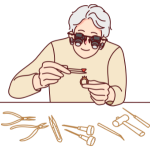What is a synthetic ruby? It’s a man-made gem that shares the same chemical makeup as natural stone. Lab grown rubies can look nearly identical to mined ones.
Today, millions of carats of rubies are created annually using high-temperature techniques. These synthetic versions aren’t fakes—they’re real rubies without the geological origin.
The Gemological Institute of America confirms they meet the same standards. But differences still exist. Inclusions, growth marks, and fluorescence can reveal the truth. This article breaks down how rubies—both mined and lab-made—differ and how to tell them apart.
What is a lab-created ruby?

A lab-created ruby is a ruby grown in a laboratory under controlled conditions. It’s not fake. It’s not plastic or glass. It’s real ruby with the same chemical composition as natural rubies.
These rubies crystallize from a mix of alumina and chromium oxide, just like those found in nature. The result? Ruby stones that look and perform like mined rubies—but at a lower price.
Lab-created rubies possess the same deep red color and shine. They rank 9 on the Mohs scale of hardness, just like their natural counterparts. You’ll find them in everything from rings to high-end watches.
Millions of carats of rubies are created this way every year using methods like the Verneuil process, flux growth, and hydrothermal synthesis.
They may not have formed over millions of years, but they’re still ruby gemstones. Understanding how they compare with natural rubies helps you make smart buying choices.
What are synthetic rubies made?
Synthetic rubies are made from the same mineral base as natural ones: corundum. This is aluminum oxide (Al₂O₃) with a bit of chromium oxide added.
That chromium is what gives rubies their red color. When the mineral crystallizes, it forms ruby crystals that are virtually identical to natural rubies.
Chemical Composition
| Component | Symbol | Purpose |
|---|---|---|
| Aluminum Oxide | Al₂O₃ | Base mineral, creates corundum |
| Chromium Oxide | Cr₂O₃ | Adds red hue, creates ruby from sapphire |
| Trace Rutile | TiO₂ | Can cause star effect (star ruby) |
Is lab created ruby real?
Yes, a lab created ruby is real. It has the same hardness, durability, and structure as a ruby found in nature. The Gemological Institute of America (GIA) classifies them as real rubies. They’re not imitations or costume jewelry.
The only difference is how they are formed. Mined rubies grow deep in the Earth. Lab-created rubies grow in a laboratory under controlled conditions. But the result is the same ruby gemstone, chemically and visually.
If you compare two ruby rings—one lab-made and one natural—you may not even tell the difference without special equipment.
How do you identify laboratory grown ruby?
To tell if a ruby is real lab-grown, you need to look beyond just color. Lab-created rubies may look perfect. But natural rubies often show small flaws.
These flaws—or inclusions—form over time in the Earth. In lab-grown rubies, you might see curved growth lines, gas bubbles, or a lack of natural zoning. These are signs of artificial formation.
Most lab rubies are made using flame fusion or flux-grown techniques. The Verneuil process, created by Auguste Verneuil, leaves curved striations not seen in natural gems. Flux-grown rubies tend to include leftover flux, which can look like fingerprints or wisps.
Here’s a quick comparison:
| Feature | Natural Ruby | Lab-Grown Ruby |
|---|---|---|
| Inclusions | Irregular, often mineral-based | Gas bubbles, curved growth lines |
| Growth Patterns | Angular, jagged | Smooth, curved |
| Formation Time | Millions of years | Weeks or months |
| Method | Found in metamorphic rocks | Created in a laboratory |
Trained gemologists use magnification and sometimes spectroscopy to learn the difference. But with a good loupe and a careful eye, you can often spot the signs.
Physical properties

Lab-grown rubies possess the same physical properties as natural ones. Both are forms of corundum, with a hardness of 9 on the Mohs scale, just below diamond.
The chemical composition of natural rubies and lab rubies is nearly identical. This includes the presence of chromium, which gives rubies their red color.
You won’t find differences in hardness or brilliance between lab and natural ruby stones. The differences lie in the growth process and internal features, not in external durability.
Price difference between natural and lab-grown rubies
Natural rubies typically carry a higher price tag. That’s because they’re rare, especially with good color and clarity.
Lab-grown rubies are more available and easier to produce. With over 10 million carats of rubies made annually in labs, supply keeps prices low.
Expect a lab ruby to cost 70–90% less than its natural counterpart. Even high-quality lab rubies will never match the value of natural rubies—especially untreated ones.
Jewelry use
You’ll find rubies in jewelry like earrings, pendants, and the classic ruby ring. Both genuine rubies and lab-created rubies are popular choices. Lab rubies offer the same beauty at a lower cost, making them perfect for budget-conscious buyers.
Natural rubies often appear in luxury pieces or heirloom collections. Some buyers prefer the story and age of natural gems, while others like the precision and clarity of rubies grown in a lab.
Either way, ruby creation, whether in the Earth or a lab, results in a durable, stunning gemstone fit for everyday wear.





Leave a Reply